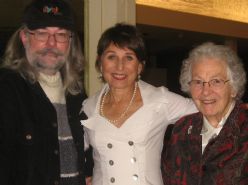|
Chamber
MC2 DUO RECITAL CLOSES 222'S SEASON
by Terry McNeill
Saturday, June 14, 2025
Choral and Vocal
CANTIAMO SONOMA'S LUSCIOUS A CAPELLA SINGING IN SEASON ENDING CONCERT
by Pamela Hicks Gailey
Sunday, June 8, 2025
Symphony
SRS SEASON ENDS WITH RESOUNDING TA-TA-TA-BANG
by Terry McNeill
Sunday, June 1, 2025
Symphony
YOUTHFUL VIRTUOSITY ON DISPLAY AT USO'S MAY CONCERTS
by Peter Lert
Saturday, May 17, 2025
Symphony
MYSTICAL PLANETS AND LIVELY GERSHWIN ORTIZ AT FINAL SRS CONCERT
by Peter Lert
Sunday, May 4, 2025
Symphony
VSO'S CONCERT MUSIC OF TIME, MUSIC OF PLACE
by Peter Lert
Sunday, April 27, 2025
VOCAL ELEGANCE AND FIRE AT THE 222'S RECITAL APRIL 26
by Pamela Hicks Gailey
Saturday, April 26, 2025
CANTIAMO SONOMA SINGS AN INSPIRED GOOD FRIDAY MOZART REQUIEM CONCERT
by Pamela Hicks Gailey
Friday, April 18, 2025
DRAMATIC SHOSTAKOVICH SYMPHONY CLOSES PHILHARMONIC'S 25TH SEASON
by Terry McNeill
Sunday, April 13, 2025
LARGE COLLEGE OF MARIN AUDIENCE GREETS STOPHER ARTISTRY
by Terry McNeill
Saturday, April 5, 2025
|
 |
 Recording Engineer Greg Bottini, Jean Alexis Smith and Organist Evelyn Schlager |
MESSIAEN PIANO PRELUDES HIGHLIGHT SMITH RECITAL IN SANTA ROSA
by Beth Zucchino
Sunday, January 27, 2013
Marin Pianist Jean Alexis Smith played a stunning recital Jan. 27 in the first 2013 concert for the Creative Arts Series. In remarks to the Resurrection Parish audience, the pianist explained that although her program has a range of styles from Baroque to Contemporary, all the composers involved wrote these works between 18 and 20 years of age.
Ms. Smith's first offering was Bach’s A Minor Prelude and Fugue in A minor, BWV 543, in the Liszt arrangement. This piece was originally an organ composition written during Bach’s Weimar period, and the Prelude is written in a Toccata-like manner. It easily lends itself to a variety of stylistic interpretations that frees the performer to play in different temps or styles. The pianist played with crystal clear articulation and maintained an organ "feel" on piano. Her style was bold and reminiscent of Glenn Gould's Bach playing, and her bass octaves evoked an organ sound.
The Fugue, written in 6/8 time, is in a much stricter tempo, usually felt in two. It is yet another example of Bach’s brilliant ability to construct a fugue based on gorgeous sequences which finally resolve to the Toccata-like cadence of the Prelude. Ms. Smith played the plaintive minor-key fugue as if she were singing the parts vocally.
Bach’s Capriccio on the Departure of a Beloved Brother (S. 992) followed and Ms. Smith's intricate counterpoint playing never overwhelmed phrases, yet the performance deftly conveyed the composer’s rounded and lyrical tones. Even in Bach's lament, she played with empathy and yet without sentimentality.
Two Chopin Nocturnes came next, short pieces from the Polish composer where the use of a melody is accompanied by loose broken chord structures played with ample damper pedal. Ms. Smith had a very unique interpretation of Chopin. In the E minor Nocturne, Op. 72 No.1, her rhythm was devoid of the usual rubato which was refreshing. Her right hand chords were ethereal and her chromatic scales appeared effortless. One might play some of the bass more delicately, yet the opening section was beautifully understated. She also played the dramatic and haunting C Minor Nocturne of Op. 48.
Messiaen’s Eight Preludes belong to his youthful works, and though the composer was only 20 in 1929 when he composed them, he had already begun to set up harmonic “modes of limited transposition” which he endowed with actual colors. One of the most interesting points in Messiaen’s modal theory was the “the resonance chord” in which combines 15 natural harmonics, ascribing to each a variety of colors. He has written, “These chords, played in turned over manner, recall the effect of refracting light through a window glass in a cathedral, a phenomenon called rainbow effect.” The titles of the Eight were The Dove, Song of Ecstasy in a Sad Landscape, The Light Number, Defunct Instants, The Impalpable Sound of Dreams, Bells of Anguish and Tears of Farewell, Calm Lamentation, and A Reflection in the Wind.
The church piano’s sostenuto pedal was missing, depriving the artist the ability to attain certain effects Messiaen wrote into the score. To this reviewer some of these preludes represented the movement of the light in the Aurora Borealis. Ms. Smith played Messiaen with variety, nuance and it was technically flawless. Messiaen's Eight Preludes hold a wide variety of moods, from frenetic to a static, and at times he seems to express his inner most state without regard for dramatic shifts. Sometimes his blocks of dissonant chords might remind one of shattered glass. Ms. Smith played all of them elegantly.
|

